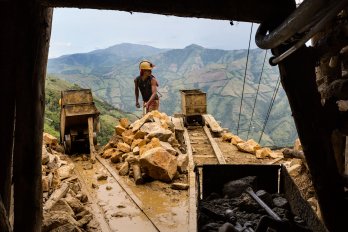At 10:55 p.m. on a winter Wednesday night, a fifty-three-year-old woman named Debra shuffles into Trinity Evangelical Lutheran Church, the site of Edmonton’s only homeless shelter for adults south of the North Saskatchewan River. She has a routine: after signing in, she slips her tennis shoes and a mickey of Blackstone vodka into a garbage bag. Then she heads to the section of the church hall reserved for women, scooting past thirty men sprawled on floor mats less than a metre apart. The garbage bag will soon double as a pillow.
Six hours and five minutes later, Debra receives her wake-up call. She’s not sure how long she actually slept; insomnia has been a companion since childhood. By 5:58 a.m., she and the other shelter goers are awake and scattering outside in the day’s minus-seven-degree weather. Banned from an A&W, public restrooms, and a bookstore because of public sleeping, Debra arrives at the local Tim Hortons and settles into a chair. “Tim Hortons is a wonderful place,” Debra says. “You can put your head down. . . . They won’t move you until the [neighbourhood cops] come.” From her jacket, Debra pulls out two crumpled tickets for trespassing—sleeping in the wrong places at the wrong times keeps landing her into trouble. She’ll need to show up to court and pay a fine or a warrant could be issued for her arrest.
It’s February, and Debra has been on the streets for the past year and a half, since her apartment lease wasn’t renewed. Sleeplessness shapes her daily life. She says she has pneumonia, cancer, and arthritis, which cause her persistent pain. Vodka, B50 supplements, and “magic” blue pills—likely stimulants—provide relief. But drugs also interfere with the little sleep she sneaks in. Exhaustion, in turn, worsens her physical pain.
Bad sleep affects marginalized people disproportionately, says Aric Prather, a clinical health psychologist in California. A 2017 study from France found that people experiencing homelessness sleep significantly less than the general population; 41 percent report insomnia. Shelter operators witness first-hand the frustration and aggression caused by exhaustion. But few shelters have the capacity to accommodate flexible sleeping schedules. In public areas, municipalities are prone to installing “hostile” architectural elements, such as tilted benches and street spikes, which are intentionally designed to prevent people from lying down. Social stigma and aggression from passersby can worsen the situation for anyone trying to find an hour of rest in a bus shelter or at a public park.
But “napping is not people being lazy,” Prather says. “Sleep is just a biological imperative for survival.” Adults need at least seven hours of sleep a day. With less than six hours of sleep, our immunity weakens. Sleeplessness can put people at greater risk of diabetes, high blood pressure, heart disease, kidney disease, stroke, and neurodegenerative diseases such as Alzheimer’s. Insufficient sleep also impairs people’s minds, hampering decision making, memory, and mood. A recent study found that adults who stayed awake for just one twenty-four-hour period had an anxiety response 30 percent stronger than others who were allowed to sleep.
Roughly 50 percent of adults experiencing homelessness also live with chronic pain—far higher than the nearly 20 percent of Canadians nationwide. Like Debra, many people in pain turn to substances to alleviate discomfort. But alcohol and drugs operate as a feedback loop: though they provide the illusion of inducing rest, they actually disturb sleep, leaving people more tired, more likely to feel pain, and more inclined to self-medicate.
The median annual cost to Canadian society for one person experiencing homelessness and mental illness was about $53,000 in 2011; up to half of that money went toward health care. We know that sleeplessness contributes to poor health, yet public discourse about the 35,000 people in Canada experiencing homelessness focuses on food, clothing, and shelter; adequate rest is typically left out of the list of basic needs. Social norms around when people should sleep, where, and with whom—also spelled out in shelter rules, loitering regulations, and policing practice—leave individuals on the street with little capacity to healthily and productively function. It’s easy to see, by applying research by scientists such as Prather, that sleeplessness exacerbates nearly every other challenge facing the homeless.
For shelters, providing decent sleep at scale is a constant challenge. I work as an ethnographer, and over the past two winters, my colleague Natalie Napier and I have shadowed more than sixty people living on the streets. Every shelter we spoke with, in Edmonton, Calgary, Montreal, Toronto, and Surrey, BC, faced the same conundrum: how to maximize occupancy and provide enough comfort for shelter users to sleep. Many of the environmental conditions affecting sleep—hours, curfews, noise, light, and smells—can, in theory, be attenuated with thoughtful physical design. Universities and companies are increasingly investing in commercial nap pods, which offer quiet, enclosed spaces. But rarely do shelter operators have resources for these perceived “nice to haves.”
Across the river from the Trinity Evangelical Lutheran Church sits Hope Mission, Edmonton’s largest shelter provider—it has 500 spots, including up to 180 squeezed into a cafeteria. The sheer number of people limits any chance of proper sleep, says Ryan Harding, Hope Mission’s outreach manager. “It’s hot, it’s noisy. . . . This isn’t designed at all to be a place where adequate rest happens.” Other cities face similar problems. In Toronto, there are seven twenty-four-hour respite centres where visitors can sleep during the day, but space and privacy remain at a premium.
Many have trouble sleeping in unfamiliar settings and among strangers. Shelters with the most space, such as Calgary’s 1,000-bed Drop-In & Rehab Centre or Montreal’s multistorey Old Brewery Mission, offer mats, single beds, or bunk beds but little choice of neighbour. Evolutionarily, humans are wired to stay alert, and hypervigilance is the most pernicious sleep disruptor, says Gilles Lavigne, Canada Research Chair in pain, sleep, and head injury at the University of Montreal. “People who live in shelters, in nonquiet and nonsafe environments, these people cannot go into deepness of sleep,” he says. Their brains are frequently scanning their surroundings for threats.
Johnny Lee, a fifty-three-year-old social-justice advocate who has lived on and off the streets for the last twenty years, says sleeping in a shelter comes with a sense of powerlessness. Staff decide whom to admit and control the environment of the shelter. He is a guest in someone else’s house—or, rather, a client in someone else’s system. “Seeing how the staff can treat us, before waking us up, setting up tables, putting mats away, getting ready to kick everyone out, they make a lot of noise,” he says. That sense of diminished agency follows Lee throughout his day. Security guards and cops will ask him to move on if he stays in one place too long or nods off. Strangers walking by might jolt him awake.
“If someone wakes you every time you sleep deeply,” Prather says, “that fragmentation . . . is going to result in just feeling bad and not rested.”
Neighbourhood police receive no training in how to wake people up, says Dan Jones, who oversees Edmonton’s downtown police division. Officers are expected to balance a duty to protect private property with community well-being. Public institutions including the Edmonton Public Library prohibit sleeping because, they say, it’s a health-and-safety risk—it potentially masks a fatal drug overdose. But banning homeless individuals from public and commercial places and then ticketing them when they break the ban is not an effective solution. It costs the government thousands of dollars, Jones says, to process a ticket, assign a Crown prosecutor, issue a warrant, arrest someone, and potentially house them in custody. “For what purpose?”
Many shelter managers across Canada argue for more affordable permanent housing. But the ethnographic research my colleagues and I have conducted suggests there is no universal recipe for healthy sleep. Private accommodation is not a panacea, and though it can provide comfort and safety for some, it won’t always address people’s psychological need for belonging and safety. In Edmonton, thanks to the help of a nonprofit organization, Debra received the keys to an apartment soon after that February morning. But the building is a bus ride away from the camaraderie and protection of her street crew. She worries she won’t be able to sleep on her own. “What am I going to do in a lonely apartment all by myself?” she says.
Given how critical sleep is to our health and well being, scientists like Prather have started framing sleep as the next frontier of social justice. Seeing sleep as a human right could change attitudes about public sleeping—normalizing the idea that proper rest, however and wherever it happens, is crucial for good health. For the average commuter, that new perspective means becoming comfortable with someone sleeping on a public bench or at the local library, without interruption.
December 17, 2019: An earlier version of this article stated that Johnny Lee has lived on and off the streets for thirty years. In fact, he has lived on and off the streets for twenty years. The Walrus regrets the error.





